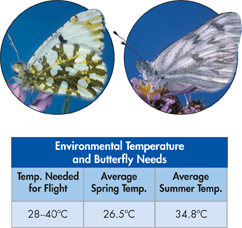Genes and the Environment
 Does the environment have a role in how genes determine traits?
Does the environment have a role in how genes determine traits?
The characteristics of any organism—whether plant, fruit fly, or human being—are not determined solely by the genes that organism inherits. Genes provide a plan for development, but how that plan unfolds also depends on the environment. In other words, the phenotype of an organism is only partly determined by its genotype.
Consider the western white butterfly, Pontia occidentalis, shown in Figure 11–13. It is found throughout western North America. Butterfly enthusiasts had noted for years that western whites hatching in the summer (right) had different color patterns on their wings than those hatching in the spring (left). Scientific studies showed the reason—butterflies hatching in the shorter days of springtime had greater levels of pigment in their wings, making their markings appear darker than those hatching in the longer days of summer. In other words, the environment in which the butterflies develop influences the expression of their genes for wing coloration.  Environmental conditions can affect gene expression and influence genetically determined traits. An individual's actual phenotype is determined by its environment as well as its genes.
Environmental conditions can affect gene expression and influence genetically determined traits. An individual's actual phenotype is determined by its environment as well as its genes.
In the case of the western white butterfly, these changes in wing pigmentation are particularly important. In order to fly effectively, the body temperature of the butterfly must be 28°C–40°C (about 84°F–104°F). Since the spring months are cooler in the west, greater pigmentation helps them reach the body temperature needed for flight. Similarly, in the hot summer months, less pigmentation enables the moths to avoid overheating.

FIGURE 11–13 Temperature and Wing Color Western white butterflies that hatch in the spring have darker wing patterns than those that hatch in summer. The dark wing color helps increase their body heat. This trait is important because the butterflies need to reach a certain temperature in order to fly. Calculate What is the difference between the minimum temperature these butterflies need to fly and the average spring temperature? Would the same calculation apply to butterflies developing in the summer? 
11.3 Assessment

-
Review What does incomplete dominance mean? Give an example.
Design an Experiment Design an experiment to determine whether the pink flowers of petunia plants result from incomplete dominance.
-
Review What is the relationship between the environment and phenotype?
Infer What might be the result of an exceptionally hot spring on wing pigmentation in the western white butterfly?
PRACTICE PROBLEM
Construct a genetics problem to be given as an assignment to a classmate. The problem must test incomplete dominance, codominance, multiple alleles, or polygenic traits. Your problem must have an answer key that includes all of your work.

Table of Contents
- Formulas and Equations
- Applying Formulas and Equations
- Mean, Median, and Mode
- Estimation
- Using Measurements in Calculations
- Effects of Measurement Errors
- Accuracy
- Precision
- Comparing Accuracy and Precision
- Significant Figures
- Calculating With Significant Figures
- Scientific Notation
- Calculating With Scientific Notation
- Dimensional Analysis
- Applying Dimensional Analysis




